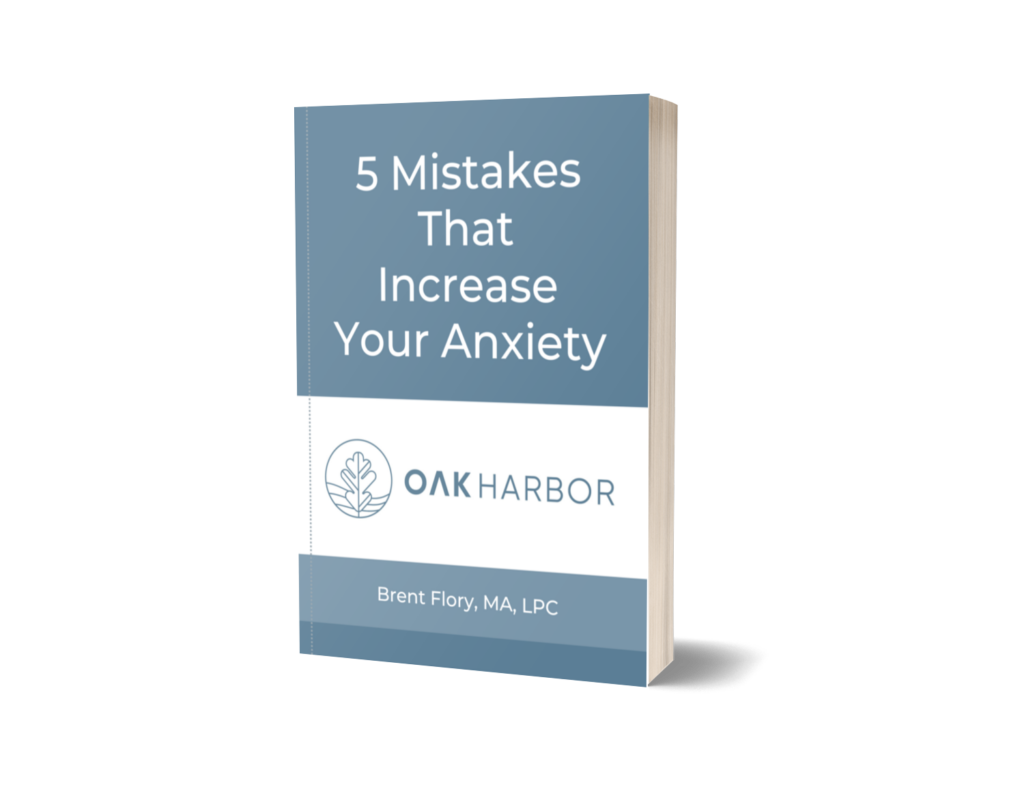The war going on in Ukraine is heartbreaking. I cannot fathom the anguish and stress that the people of Ukraine are facing amid the violence. How do you cope with such a horrific situation?
I reflected recently on what I would do as a counselor if I had ten minutes to speak with a Ukrainian refugee. With so little time, how could I best help them? Would I listen to their story? Would I try to share something that could benefit them?
Of course, I would listen to their story with compassion. But if all I did was listen for ten minutes without teaching them anything helpful, I would fail them. They are in great pain and must make some difficult decisions. This is the first skill I would teach someone in such dire circumstances.
The Best Skill to Help You Cope with Feeling Overwhelmed
The skill is called Dropping Anchor. In life, we all face storms that threaten to carry us away. War is arguably the fiercest storm in life. But there are others. Your storm may be the loss of a job, battling anxiety or depression, or the ending of a relationship.
I learned about Dropping Anchor from Russ Harris, a leading practitioner and trainer of Acceptance and Commitment Therapy. Russ was a part of a group that created an ACT protocol for the World Health Organization to use in refugee camps. Dropping Anchor was one of the first exercises included in that protocol. Russ gets the credit for this metaphor and exercise.
A Picture of Where We Are Going
Imagine you and I have decided to start a fishing company. This is ironic because I’ve never caught a fish in my entire life. But you forgot to ask me that key question before we went into business together.
We are living out on the coast and have bought a small fishing boat. It’s so tiny, it’s really a dinghy. Which is way more fun to say (and write).
One early morning, we head out to do some deep-sea fishing. As we are about to leave the harbor, we see a massive storm front heading straight towards us. If we go into that storm, our boat is not likely to survive, and neither are we. The smart move is to go back to harbor, drop anchor, and ride out the storm.
The point of this metaphor is that in life, we all face storms that threaten to carry us away. We cannot avoid them. We cannot outrun them. Dropping Anchor can help you ride out your storm.
First, I am going to briefly share the three components that make up Dropping Anchor. Then in the following section I will give an at length script on how to do each component.*Most if not all of these strategies come from Acceptance and Commitment Therapy, which I learned from Russ Harris. He’s a leading practitioner and trainer of ACT. He’s a big deal, and I’m a huge fan.
The Three Components of Dropping Anchor
1. Acknowledge your inner experience.
It is impossible to do anything about a problem that we are unaware of or that we refuse to acknowledge. The first step to dropping anchor is to simply notice and acknowledge what I am experiencing.
2. Connect with your body.
The second step is to connect with your body when you’re in stressful circumstances. We have all experienced getting trapped in our heads by fear, anxiety, or reoccurring thoughts. You can reconnect with your body even when you feel overwhelmed. You can’t control what you think and feel. But you can regain a sense of control in an overwhelming situation by moving your body.
3. Engage with the world around you.
The third step is to engage with the world around you. What can you see? Hear? Touch? Taste? Smell? When we find ourselves living in a harsh reality, being in tune with the world around us is difficult. But it is necessary. You can’t take action if you’re trapped in your thoughts and emotions.
Script for How to Drop Anchor
First, get into a comfortable position. For many people, it helps to sit down, straighten your back, and put your feet flat on the floor. You can keep your eyes open, or you can close them.
1. Acknowledge your inner experience.
There are three parts to acknowledging your inner experience. You are going to practice shifting your focus from your thoughts, to your emotions, to scanning your body.
A. Notice your thoughts.
Seek to notice the thoughts cutting across your mind. Don’t put any sort of judgment on them as good or bad, just notice them. You can say something to yourself like, “I’m noticing that I’m having the thought that X.”
B. Notice your emotions.
Next, try to notice what emotions or feelings are rising to the surface. If you can name the emotion, say something to yourself like, “I’m noticing that I’m having a feeling of X.” If you feel numb you can say, “I’m noticing that I am feeling numb.”
C. Scan your body.
Then scan your body. Scan from the top of your head, down your neck, shoulders, and arms all the way down your upper body. Scan down your legs, all the way to your toes. Notice any areas of discomfort or tension in your body.
Notice what your body is experiencing with openness and curiosity. Tap into a curious mindset like a kid who found an insect in the backyard they’ve never seen before.
2. Connect with your body.
After you acknowledge the thoughts, the feelings, and the sensations showing up, shift your focus to your feet. Practice pressing your feet into the floor and put your full attention on what that feels like.
Then straighten your back. Notice how your back is supporting you and giving you strength.
Next, have a good stretch, however you like, however feels comfortable. Stretch where you feel tension or tightness. I tend to carry my stress in my shoulders and neck so I often stretch those areas out. As you’re making these movements, notice how you have control over your body and your actions. Even in the midst of a difficult situation.
You are not trying to distract yourself from or fight the difficult thoughts, feelings, or sensations that are showing up. You want to notice and acknowledge them for what they are. Then you want to practice shifting your attention.
3. Engage with the world around you.
So practice shifting your focus from your inner world to the world outside you. Open your eyes if they aren’t already and notice three or four things that you can see. Take them in as if you’re seeing them for the first time. Notice what you can hear in the room or outside of the room. Finally, engage with the world around you and act on what is most important to you in this moment.
Pointers to Dropping Anchor
Here are a few things to keep in mind with this simple but powerful exercise:
1. Dropping Anchor is very flexible.
The components of dropping anchor are important but how you exercise them is not. In other words, you need to acknowledge, connect, and engage (think ACE), but there are different ways to do so.
For example, imagine you are in a restaurant with a friend. During your conversation, you get caught in your mind by a negative thought. You don’t have to visibly stretch to connect with your body, or look around to engage with the outside world.
Instead, you can subtly rub your fingertips on your jeans and focus on what that feels like. Next, you can focus on the aromas in the restaurant. And then refocus on giving your friend your full attention.
You can also drop anchor quickly. With practice, as you get more comfortable with it, you can learn to Drop Anchor in 10 seconds.
2. You can’t overdo Dropping Anchor.
Overdosing is a serious risk with prescribed medications. If you take a higher dose than prescribed, you could experience more side effects and harm yourself.
Dropping Anchor is nothing like a medication. Some days you may Drop Anchor once or twice, and that is plenty. On a stressful day, you may need to drop anchor more times than you want to count.
That is completely okay. You cannot ‘overdose’ on Dropping Anchor. Its purpose is to help you be present and do what’s most important to you.
Where People Get Confused with Dropping Anchor
Dropping Anchor can be an incredible tool for you. But like many tools, Dropping Anchor is designed for a specific purpose. It’s not a Swiss Army knife, that can fulfill twenty different jobs. If you use it for the wrong reason, it can backfire on you.
People often come to me for help because they want to feel better. Which is completely understandable. And I want to help them achieve their goal. But sometimes they are so determined to achieve that goal that they sabotage their opportunity to get relief.
Consider this scenario: Someone comes to me wanting to feel better and I teach them Dropping Anchor. Imagine I tell them the goal of Dropping Anchor is to feel better. So they use it, and eureka, they feel better!
“Put first things first and we get second things thrown in: put second things first & we lose both first and second things.” -C.S. Lewis
Sometimes in this life, no matter what you do, you won’t feel better. If you suffer a tragic loss, nothing will take away your pain. But you can take action and do what’s most important to you in that moment.
The primary goal of dropping anchor is to help you be present in the moment.
Dropping Anchor empowers you to be present in the moment. When you and I engage in the present, we can take valued action to better our lives.
Imagine they are caught up in their head, replaying events that have occurred and are overwhelmed with anxiety. Their suffering is absolutely understandable from all they have been through. But if they stay stuck in their suffering, they are going to deeply struggle to take meaningful action.
In difficult situations, you need to be present in the moment to act. As a great side benefit, many of my clients feel better after Dropping Anchor when they make being present their focus. But being present must be your primary goal for this exercise to serve you well.
Practice
As we all know, learning a new skill takes practice. You won’t remember to use it when life is difficult without practicing it. Here is my prediction; you will get out of Dropping Anchor what you put into it.
If you have learned to play an instrument like the guitar, you have put a lot of time into it to build your skill. Why not practice dropping anchor for 5-10 minutes a day for the next month? Each time you try it, measure on a scale of 1-10 (1 is completely trapped in your thoughts/emotions and 10 is fully present) how present you are before and after doing Dropping Anchor.



